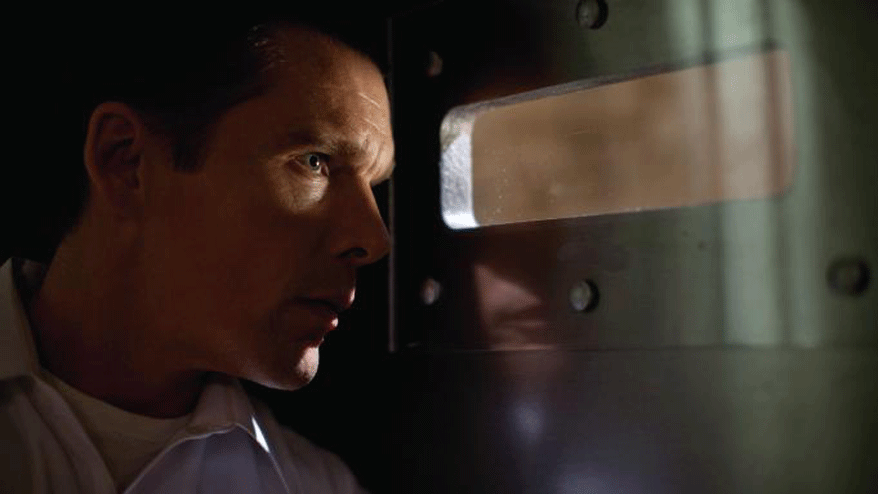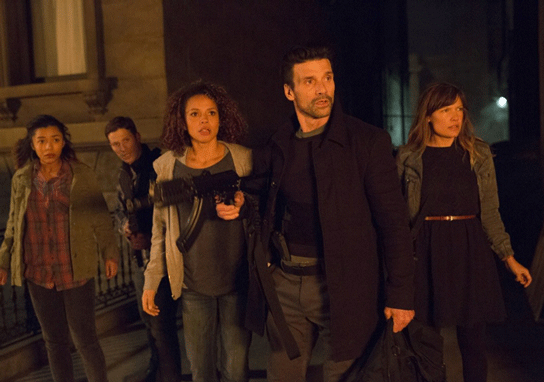When The Purge was first released, it was widely criticized for lacking the ambition necessary to tackle the social allegory at work.
The Purge focuses on a pro-Purge family, one whose patriarch (Ethan Hawke) installs security systems for wealthy customers who opt to hide in their McMansions for the one night of the year when all crime is legalized.
That’s the premise behind the franchise. The “New Founding Fathers” have passed legislation legalizing crime for a night, in an effort to reduce crime overall.

This is only briefly touched upon in the first film, which operates in the familiar terrain for horror fans of the home invasion thriller. After Hawke lets in a wounded civilian, his family becomes the target of some Purgers. Early scenes show Hawke and his wife speaking highly of the Purge, so it’s a little hard to empathize.
Though home invasion thrillers have their limitations - intentionally. In hindsight, however, writer/director James DeMonaco was setting up a blueprint to address an issue that’s very much an obstacle to the United Nations Sustainable Development Goals (SDGs), namely how societies often intentionally use the social inequalities of minorities to distract from political realities designed to keep them in their place. The film’s plot focusing on crime and redressing unstable social relations also touches the SDG advocating for Peace, Justice and Strong Institutions.
By the second film, it’s understood by the citizenry that the New Founding Fathers’ actual goals have nothing to do with crime rates. This is apparent in the pirate TV broadcasts that anti-Purger Carmelo Johns (Michael K. Williams) manages to transmit.
In what could be a callback to the 70s B-films from which it draws inspiration, Williams hasn’t quite mastered the internet yet. And Williams’ spiel isn’t far removed from a late-period George Carlin comedy bit, just without the jokes.
It appears the lower classes aren’t killing themselves in great enough numbers, so state-sponsored assassins have been brought in to bring them up. While doing so, they also figure it’s a good time to do some gentrification-through-murder, with a Latin American waitress and her daughter’s (Carmen Ejogo and Cali Sanchez) apartment complex slated for demolition.
The Purge: Anarchy does what any sequel is meant to and ups the stakes and gives us protagonists worth caring about, following off-duty LAPD officer Leo Grass (Frank Grillo) as he plots to execute the man who killed his son in a drunk driving accident. He’s quickly sidetracked with Ejogo and Sanchez, though, and spends the film as their protector.

You don’t have to search far online for thinly veiled comments from controversial figures about how the marginalized should be eliminated. There was some of that in Lt. Governor of Texas Dan Patrick’s belief that “lots of grandparents” should be willing to die of COVID-19.
That’s not far removed from Ejogo’s father, dying of an undisclosed illness, putting himself up for slaughter in order to leave some money for her.
In our own case, we didn’t need a Purge; there was a handy, potentially lab-leaked, illness to do the dirty work for it. Even this Washington Post study finds that poor Americans die younger than their wealthy counterparts.
It’s only in the third film that we meet the New Founding Fathers. In The Purge: Election Year, an anti-Purge candidate (Elizabeth Mitchell) is the frontrunner and the Fathers must orchestrate her assassination. However, these themes and ideas were already swimming within the fabric of the last film, including that the Fathers are essentially similar to a certain type of hypocritical right-wing American Christian.
Much has been written of this type of modern conservative American Christian and their hypocrisies. After Trump became their favourite candidate, it was hard to find a newspaper or internet writer that didn’t equate it to a deal with the devil. Even producer Jason Blum claimed he saw The Purge in Trump, though producers often make claims to inflate box office.
So it’s fitting that The First Purge, released at the height of the popular Trumpian Make America Great Again movement (MAGA), makes no secrets about the Purge’s inspiration. But the franchise works much better when it’s broader.
The First Purge feels more potent because it’s directly speaking to current events, with a blonde, gun-toting Marisa Tomei that’s instantly recognizable as a stand-in for the Tomi Lahrens and Dana Loesches currently in the media.
The connections to Trumpian politics may appear to be on the surface. They’re great for think pieces written during the release, but they lose their timeliness. Though it’s worth noting that some of Trump’s proposals for dealing with hurricanes (“nuke them”) and other problems are just as outlandish as a Purge scenario.
But The Purge predates Trump’s administration, and they’ll still be releasing films and television spin-offs well after him as well. These aren’t Trumpian issues, they’re American ones.
The Purge films are, at heart, B-movies that joyfully mix and match genres with a love of extreme violence and broad, social allegory. The audience’s enjoyment of them will depend on whether or not that appeals to you.
There are more subtle works that talk about class warfare, but The Purge is an American franchise. It’s not without its problems. The first two, in particular, can still easily be seen as white saviour films.
It’s a blunt, open embrace of horrific ideas we never hear publicly but are just underneath the surface of a lot of TV rhetoric. By becoming the logical extension of those ideas, it becomes their best opponent.
B-movies don’t necessarily provide answers to building a better, more sustainable world, but they certainly provide insight into the obstacles we face. To learn how we can actually create a better world, please visit the United Nations site on the Sustainable Development Goals, here.
